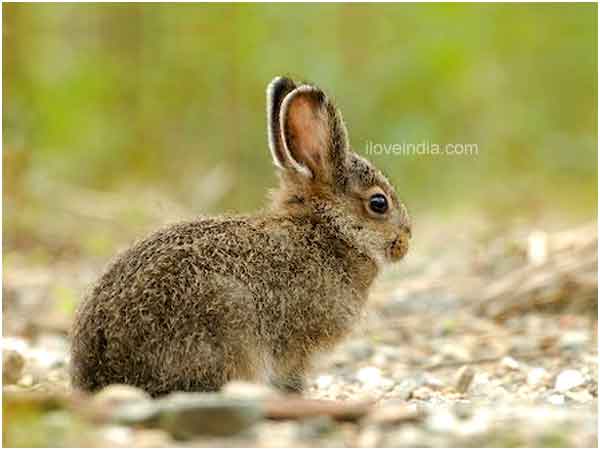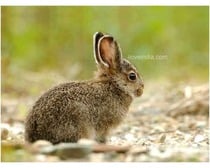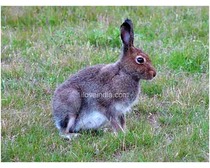Hare is a fast moving nocturnal animal that does boxing with its counterparts. Read on to find more interesting facts and amazing information on hares.
Facts About Hare
Remember the famous story of hare and tortoise, in which the fast moving hare ridicules the slow moving tortoise by challenging him in the forest race. And because of being overconfident of his win, loses it to the tortoise. It gave a new lesson to the people that ‘slow and steady wins the race’. While the story may or may not be true, it is a fact that hare is fast moving animal. Native to Northern, Central, and Western Europe and Western Asia, it has the scientific name Lepus europaeus. Its long, powerful hind legs and short black and white tail facilitates it to rush at great speed. This rabbit-look-alike can be identified with its warm-colored brown fur, with orangey-yellow fur on face, throat and flanks. Hare has white under parts, long, black-tipped ears and large, staring eyes that differentiate it from the other members of the Leporidae family. Read on to know some more interesting facts and amazing information on this fast, yet shy animal.

Facts About Hare
Binomial Name: Lepus europaeus
Kingdom: Animalia
Phylum: Chordata
Subphylum: Vertebrata
Class: Mammalia
Order: Lagomorpha
Family: Leporidae
Subfamily: Homininae
Genus: Lepus
Type Species: Lepus timidus
Species: Hares, Jackrabbits, Caprolagus or the Hispid Hare, and Pronolagus or the red rock hares
Height: 52 - 59.5 cm
Weight: 2.5 to 6.5 kg
Life Span: 11 years
Diet: Herbivorous, eating grasses, herbs, and field crops during summer
Range: They are native to Eurasia, Africa, and North and Central America; they have been introduced into Australia in recent times.
Habitat: meadows, brushy country, and woodland clearings
Age of Sexual Maturity: 8 months (males and females)
Gestation Period: 4 days
Number of Offspring: 2 to 4 (in each litter)
Interesting & Amazing Information On Hares
- Hare is related to rabbit. Both of them belong to the same family, but have a different genus.
- Brown hares are a brown-russet color, with a white underside. The tail is black on the upper surface and white underneath.
- Hare is usually a solitary mammal that does not dig burrows, rather lives entirely above the ground. It can even live in pairs or groups that are known as droves (for groups).
- A common type of hare in Arctic North America is the Snowshoe Hare, replaced further south by the Black-tailed Jackrabbit, White-tailed Jackrabbit and other species.
- With its long hind legs and sleek body, a hare can run at a speed of 72km/h (45mph) on sensing danger and can also outwit its enemy by swerving and running in a zigzag fashion.
- Hare is predominantly a nocturnal animal that ventures out at night, grazing on the young shoots of grasses and herbs as well as agricultural crops and hence is a pest for agricultural lands.
- The best time to see a hare is in early morning or at dusk, when it is feeding. In-between nibbling plants, it frequently sits up to have a good look all around.
- During the day, it rests and sleeps in a form, which it makes by scraping out a shallow depression in the ground, just fitting its body when crouching low. The form may be against a hedge, in short grass, scrub or a ploughed furrow.
- Hare has a keen sense of smell and hearing that helps it detect predators. It moves slowly and carefully, so as to remain inconspicuous.
- It is able to adapt to a variety of habitats and for this very reason, is one of the most widely distributed land animals in the world.
- Hare makes low grunts from time to time and "guttural" calls from the doe (female) to her leverets. The European hare grinds his teeth as an alarm call. It also emits a shrill call when hurt or caught.
- Hare has been hunted by man for centuries, for both meat and sports. It is categorized under least concerned category of animals and since it is classed as a game animal, there is little legal protection to save it.
- Hares re-ingest their own droppings, so that food passes twice through the digestive system.
- They can breed at any time of year, but the main season is between January and October, with most young ones born between March and September.
- During mating season, hares can be seen boxing with each other. The jacks (males) do most of the boxing, either with each other- in a struggle for social dominance, or with jills (females) - as a prelude to mating.
- The female hare boxes with the male, either to show that she is not yet quite ready to mate or as a test of his determination. A single male hare will mate with several females.
- Female hares typically give birth to around three litters every year, each having two to four young hares (leverets). Leverets are born with their eyes open, and are left alone in the day in forms, to avoid attracting predators.
- In rural areas of North America, hare was a common source of meat. However, because of their extremely low fat content, they are a poor choice as a survival food. Hare meat is said to be white and delicious.


See also
More from iloveindia.com
- Home Remedies | Ayurveda | Vastu | Yoga | Feng Shui | Tattoos | Fitness | Garden | Nutrition | Parenting | Bikes | Cars | Baby Care | Indian Weddings | Festivals | Party ideas | Horoscope 2015 | Pets | Finance | Figures of Speech | Hotels in India : Delhi | Hyderabad | Chennai | Mumbai | Kolkata | Bangalore | Ahmedabad | Jaipur
- Contact Us Careers Disclaimer Privacy Policy Advertise With Us Lifestyle Sitemap Copyright iloveindia.com. All Rights Reserved.





